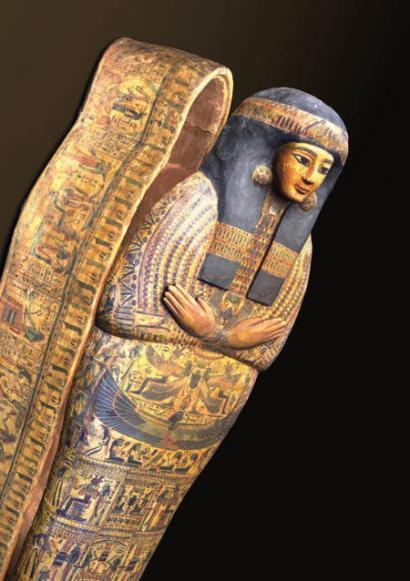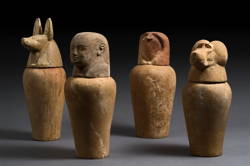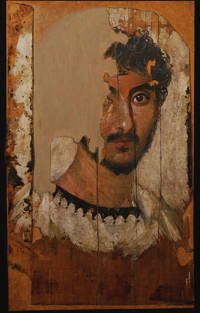
Sarcophagus, 3rd Intermediate Period,
Deir el-Bahari, Bab el-Gasus, 2nd Cache,
wood, stucco and paint, 182x62x52 cm
|
|
MUSÉE DU CINQUANTENAIRE
Parc du Cinquantenaire 10
B-1000 BRUSSELS
INFORMATION:
• Tel: +32 (0)2 741 72 11
• Email: info@mrah.be
• Website: www.mrah.be
OPENING HOURS:
• From Tuesday to Sunday, 10 a.m. to 5 p.m. (tickets are sold until 4 p.m.)
• Closed on 1 and 11 November, 25 December and 1 January.
• The museum closes at 2 p.m. on 24 and 31 December
RATES:
• Normal rate: €13
• Reduced rates: €7 and €10
• Includes access to the permanent collections and the exhibition Djehutihotep – 100 years of excavations in Egypt
CURATORS:
• Luc Delvaux
• Isabelle Therasse
PRESS CONTACT:
Denis Perin, Communication Officer
d.perin@mrah.be
+32 (0)2 741 72 90

|
Eternity! To live once more like the god of the afterlife Osiris, or to rise again like the sun that is born from the womb of Nut, godess of the sky... The ancient Egyptians had high expectations of life after death! The Cinquantenaire Museum will unveil the secrets of the Egyptian sarcophagi as well as some true masterpieces of the Museum collections, including coffins, death masks and embalmed cats, many of which have never been shown before.
 Canopic jars, Late Period, unknown provenance, Petrie Gift, 1913, limestone, 29x10 cm.
The exhibition follows the sun during her nightly journey towards the dawn where she will be born anew. A journey encompassing the so-called twelve hours of the night. Every gallery, or every nightly hour, features an eye-catching centrepiece chosen for its rich religious, funerary, historical or aesthetic qualities. During the ‘first hour’ the visitor experiences the Egyptian mourning ritual through the display of four remarkable statues of wailing women that cry over the deceased. The ‘second hour’ shows us the items the dead needed to bring with them to ensure safe passage to the realm of Osiris, god of the Afterlife. The hours that follow provide us with a chronological sketch of the evolution of sarcophagi from ordinary non adorned coffins from the prehistoric era and the Old Kingdom, to the richly decorated examples of the later periods. One hall will be entirely dedicated to the ancient Egyptian process of mummification.
Restoration right before your eyes
The ancient Egyptians called their mummification centres Ibu, meaning Pure Place. Taking centre stage is the restoration laboratory where you can see the experts of the Istituto Europeo del Restauro in Ischia (Italy) at work. They will be restoring the ten sarcophagi and ‘mummy planks’ from the Second Cache of Deir el-Bahari that are part of the collections of the Cinquantenaire Museum. The exhibition will try to unravel the complex secrets of these sarcophagi. About 2/3 of the objects that will go on view have never before be shown to a larger audience. The archaeological adventures that led to their discovery will be explained in detail as will the magical and mythological implications these objects held for the ancient Egyptians. Objects where every element, however small, was significant.
 Fayum Portrait, Roman Period, unknown provenance, painted wood, 30x21 cm.
Last but not least: witness first-hand how these artefacts were constructed in the pop-up restoration laboratory. While the direct restoration of the sarcophagi of Deir el-Bahari in the laboratory set up in the center of the exhibition will reveal the production secrets of these works, the results of the tests carried out at the Cliniques universitaires Saint-Luc will be presented in the exhibition. The mummies studied will hold very few secrets from visitors after this! Three scan sessions over 10 human mummies and 15 animal mummies have been held since the month of August. These scans give us information in particular on the life span of the individuals concerned as well as their health at the moment of their death. More globally, they enrich the limited written and iconographic sources regarding the funerary practices and the technical gestures the embalmers carried out during the mummification process.
• As of 6 November 2015, visitors will also be able to visit Djehutihotep – 100 years of excavations in Egypt. This dossier exhibition is organised in collaboration with the KULeuven. Entry is included in a ticket to the Sarcophagus exhibition or the Museum collections.
To see other illustrations, click on Version Française, at the top of the page
|










